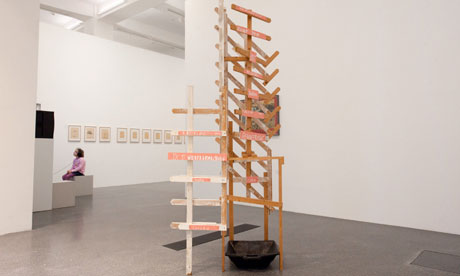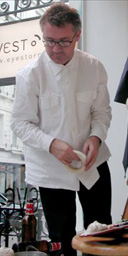It happened again - this time in Germany -- RUBBISH ART
Overzealous cleaner ruins £690,000 artwork that she thought was dirty
She scoured off a layer of paint in a sculpture by late German artist Martin Kippenberger on loan to a museum in Dortmund

The artwork, entitled When It Starts Dripping From The Ceiling, consists of a trough under a wooden tower of slats.An overzealous cleaner in Germany has ruined a piece of modern art worth £690,000 after mistaking it for an eyesore that needed a good scrub.
The sculpture by the German artist Martin Kippenberger, widely regarded as one of the most talented artists of his generation until his death in 1997, had been on loan to the Ostwall Museum in Dortmund when it fell prey to the cleaner's scouring pad.
The work, called When It Starts Dripping From the Ceiling (Wenn's anfängt durch die Decke zu tropfen), comprised a rubber trough placed underneath a rickety wooden tower made from slats. Inside the trough, Kippenberger had spread a layer of paint representing dried rainwater. He thought it was art: the cleaner saw it as a challenge, and set about making the bucket look like new.
A spokeswoman for the museum told German media that the female cleaner "removed the patina from the four walls of the trough".
"It is now impossible to return it to its original state," she said, adding that it had been on loan to the museum from a private collector and was valued by insurers at €800,000 (£690,000).
She said that cleaning crews had been told to keep 20cm (8in) away from artworks, but it was unclear if the woman – who worked for a company to which cleaning had been outsourced – had received the memo.
If Kippenberger is now turning in his grave, he may find solace in the fact that he is not the only artist to have his works ruined by cleaners. In 1986, a "grease stain" by Joseph Beuys valued at about €400,000 was mopped away at the Academy of Fine Arts in Düsseldorf.
At least the artwork didn't end up in a skip. In 2004, a cleaner at Tate Britain in London threw away*** part of a work by another German artist, Gustav Metzger, after mistaking it for rubbish. The cleaner failed to realise that a plastic bag containing discarded paper and cardboard was an integral part of Recreation of First Public Demonstration of Auto-Destructive Art, and not just some litter. The bag was later recovered, but it was too damaged to display, so Metzger replaced it with another bag.
Germans are not the only victims. In 2001, Damien Hirst lost a pile of beer bottles, ashtrays and coffee cups, meant to represent the life of an artist, when a caretaker at the Eyestorm Gallery in London cleared it away###.
| The bag of rubbish was part of Metzger's Recreation of the First Public Demonstration of Auto-Destructive Art |
A bag of rubbish that was part of a Tate Britain work of art has been accidentally thrown away by a cleaner.
The bag filled with discarded paper and cardboard was part of a work by Gustav Metzger, said to demonstrate the "finite existence" of art.
It was thrown away by a cleaner at the London gallery, which subsequently retrieved the damaged bag.
The 78-year-old artist replaced it with a new bag. The gallery would not reveal whether he would be compensated.
'Integral part'
The bag was part of Metzger's Recreation of First Public Demonstration of Auto-Destructive Art, a copy of a piece he produced in 1960.
Tate Britain said the work "is made up of several elements, one of which is a rubbish bag included by the artist as an integral part of the installation".
"On 30 June, the bag was accidentally removed and damaged but was subsequently replaced."
The gallery said the work is now covered over at night so it cannot be removed again, and staff have been made aware that the rubbish bag is part of the exhibit.
 Damien Hirst's 2001 installation was also mistaken for rubbish |
Metzger, a German artist who lives in east London, invented "auto-destructive" art in 1959.
The work also features an "acid painting" - nylon covered in acid which slowly destroys it to illustrate the transient nature of paintings, sculptures and other artworks.
It is part of the gallery's Art and the 60s exhibition, which looks at art after 1956 and also includes works by David Hockney and Peter Blake.
It is not the first time such a mistake has been made. In 2001 a cleaner at a London's Eyestorm Gallery gallery cleared away an installation by artist Damien Hirst, having mistaken it for a pile of rubbish.
The collection of beer bottles, coffee cups and overflowing ashtrays was said to represent the chaos of an artist's studio.
And in the 1980s the work of Joseph Beuys, which featured a very dirty bath, was scrubbed clean by a gallery worker in Germany.###Cleaner clears up Hirst's ashtray art

Emmanuel Asare thought the piles of full ashtrays, half-filled coffee cups, empty beer bottles and newspapers strewn across the gallery were the remnants of a party in the west London gallery.
Although that is what it was, this rubbish had been arranged by Hirst into an impromptu installation, which increased its value by thousands.
Hirst had arrived at the launch party of a new exhibition of his work, Painting-By-Numbers, on Tuesday night at the Eyestorm gallery. When asked how he would like his prints to be displayed in the windows, the artist, famed for his formaldehyde animals, decided to create a new work.
The next morning when Mr Asare arrived for work, he decided to clean up the mess straight away by putting it all in bin bags. Mr Asare said: "As soon as I clapped eyes on it I sighed because there was so much mess.
"I didn't think for a second that it was a work of art - it didn't look much like art to me. So I cleared it all into binbags and dumped it."
Staff were dispatched to find the binbags in the rubbish, and salvaged the various objects, which they used to reconstruct the installation from photographs taken earlier.
Hirst, 35, said the piles of junk represented an artist's studio and said the mistake was "fantastic. Very funny."
Charles Thomson, co-founder of the Stuckist art movement, which favours the traditional skills of drawing and painting, praised Mr Asare's action.
"The cleaner obviously ought to be promoted to an art critic of a national newspaper. He clearly has a fine critical eye and can spot rubbish, just as the child could see that the emperor wasn't wearing any new clothes," he said.

 Earth's magnetic field:
Earth's magnetic field:

0 Comments:
Post a Comment
<< Home